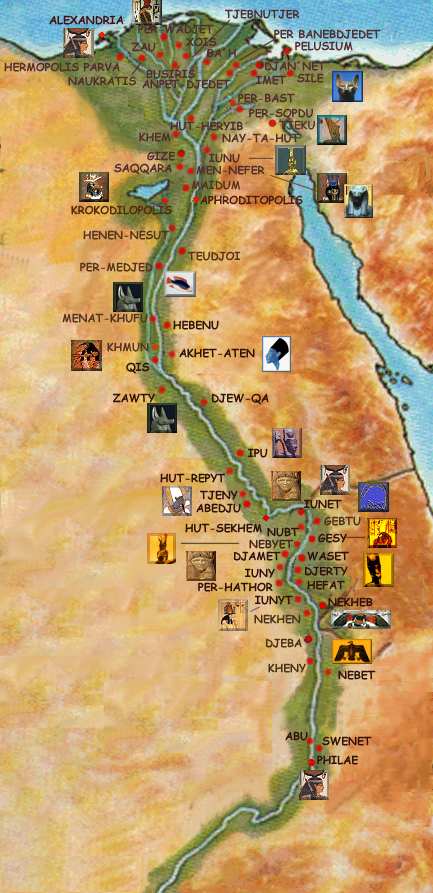

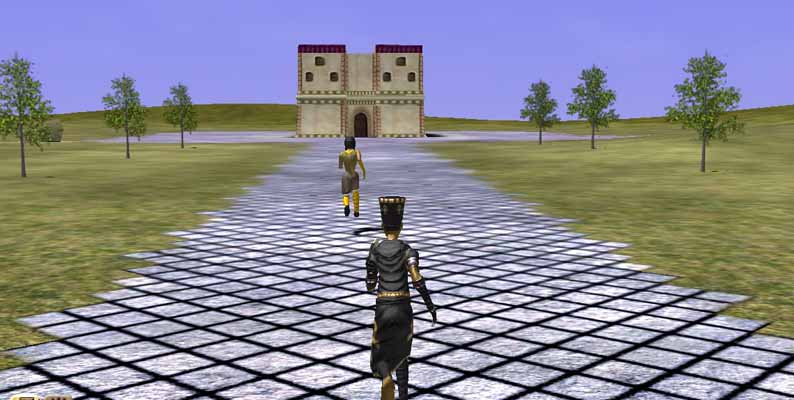
Temples were found everywhere in ancient Egypt as a place to worship their endless pantheon of major and minor gods Each city had a temple built for the god of that city, which acted as a cosmic center by which men had communication with the gods. As the priests became more powerful, tombs became a part of great temples.
The highest priest for any and all gods was of course Pharaoh, who in his turn appointed high priests and other priests to perform his duties to the gods. And it was only Pharaoh or the priest on duty who was ever allowed into the innermost chamber of the temple, where the naos was kept (the shrine built of wood), where the statue of the god was situated. This they did only at the morning ceremony, the midday and evening ceremony. At all other times no one entered that part of the temple.
The rest of the priesthood were the only ones who were allowed beyond the outer court. The worshippers (the Shemsu) were never allowed further than the outer court, where they could leave their offerings to priests who brought them into the temple. So the temple was indeed considered the home of the god, it did not function like the temples of other cultures where people come and go more or less as they please. These temple precincts were the domains of the god, who was believed to be resident in actual fact.
The most important task of the priesthood was to see to it that the god was well cared for and got everything that he could need. They were indeed "servants of the god". They had the duty to ensure that the god wanted to remain in his home and in Egypt so that all would be well. If he were to be discontent he would no longer protect the land but leave it.
But the relationship between the average Egyptian and his god was nevertheless an intense one. Those who lived near an important cult center or even a smaller temple could always go to the outer court and leave their offerings and there was also a backdoor behind the main building where they could hand in their ostraca on which they had scribbled prayers and questions, or they could whisper their troubles to an attending priest. The priests took care of it and usually provided the questioner with an answer of sorts.
Then there were the festival days when the god was carried on his bargue in procession through the city. At those occasions the precessional route was lined with worshippers and residents who came to get a glimpse of the statue, even though it was usually hidden with hangings and shaded with great ostrich feathers. These festive occasions were much cherished and longed for, and it was probably allowed then for the commoner to enter the temples and, after having made a suitable offering he could perhaps wander across the holy courtyards and maybe visit the place where the sacred animals were kept.
Ancient Egyptian temples were meant as places for the gods to reside on earth. Indeed, the term the Egyptians most commonly used to describe the temple building, A god's presence in the temple linked the human and divine realms and allowed humans to interact with the god through ritual. These rituals, it was believed, sustained the god and allowed it to continue to play its proper role in nature. They were therefore a key part of the maintenance of Maat, the ideal order of nature and of human society in Egyptian belief. Maintaining Ma'at was the entire purpose of Egyptian religion, and thus it was the purpose of a temple as well.
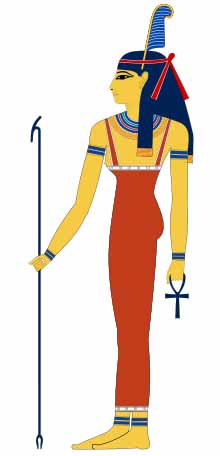
Because he was credited with divine power himself, the pharaoh, as a sacred king, was regarded as Egypt's representative to the gods and its most important upholder of Ma'at. Thus, it was theoretically his duty to perform the temple rites. While it is uncertain how often he actually participated in ceremonies, the existence of temples across Egypt made it impossible for him to do so in all cases, and most of the time these duties were delegated to priests. The pharaoh was nevertheless obligated to maintain, provide for, and expand the temples throughout his realm.
Although the pharaoh delegated his authority, the performance of temple rituals was still an official duty, restricted to high-ranking priests. The participation of the general populace in most ceremonies was prohibited. Much of the lay religious activity in Egypt instead took place in private and community shrines, separate from the official temples. However, as the primary link between the human and divine realms, temples still attracted considerable veneration from ordinary Egyptians.
Each temple had a principal deity, and most were dedicated to other gods as well. However, not all deities had temples dedicated to them. Many demons and household gods were involved primarily in magical or private religious practice, with little or no presence in temple ceremonies. There were also other gods who had significant roles in the cosmos but, for uncertain reasons, were not honored with temples of their own.
Of those gods who did have temples of their own, many were venerated mainly in certain areas of Egypt, though many gods with a strong local tie were also important across the nation. Even deities whose worship spanned the country were strongly associated with the cities where their chief temples were located.
In Egyptian creation myths, the first temple originated as a shelter for a god - which god it was varied according to the city - which stood on the mound of land where the process of creation began. Each temple in Egypt, therefore, was equated with this original temple and with the site of creation itself. As the primordial home of the god and the mythological location of the city's founding, the temple was seen as the hub of the region, from which the city's patron god ruled over it.
Pharaohs also built temples where offerings were made to sustain their spirits in the afterlife, often linked with or located near their tombs. These temples are traditionally called "mortuary temples" and regarded as essentially different from divine temples. However, in recent years some Egyptologists, such as Gerhard Haeny, have argued that there is no clear division between the two.
The Egyptians did not refer to mortuary temples by any distinct name. Nor were rituals for the dead and rituals for the gods mutually exclusive; the symbolism surrounding death was present in all Egyptian temples. The worship of gods was present to some degree in mortuary temples, and the Egyptologist Certain temples were clearly used to commemorate deceased kings and to give offerings to their spirits. Their exact purpose is not fully understood; they may have even been meant to unite the king with the gods, elevating him to a divine status greater than that of ordinary kingship. In any case, the difficulty of separating divine and mortuary temples reflects the close intertwining of divinity and kingship in Egyptian belief.
Temples were also key centers of economic activity. Large ones required prodigious resources and employed tens of thousands of priests, craftsmen, and laborers. The temple's economic workings were analogous to those of a large Egyptian household, with servants dedicated to serving the temple god as they might serve the master of an estate. This similarity is reflected in the Egyptian term for the temple lands and their administration, pr, meaning "house" or "estate".
Some of the temple's supplies came from direct donations by the king. In the New Kingdom, when Egypt was an imperial power, these donations often came out of the spoils of the king's military campaigns or the tribute given by his client states. The king might also levy various taxes that went directly to support a temple. Other revenue came from private individuals, who offered land, slaves, or goods to temples in exchange for a supply of offerings and priestly services to sustain their spirits in the afterlife.
Much of a temple's economic support came from its own resources. These included large tracts of land beyond the temple enclosure, sometimes in a completely different region than the temple itself. The most important type of property was farmland, producing grain, fruit, or wine, or supporting herds of livestock. The temple either managed these lands directly, rented them out to farmers for a share of the produce, or managed them jointly with the royal administration.
Temples also launched expeditions into the desert to collect resources such as salt, honey, or wild game, or to mine precious minerals. Some owned fleets of ships with which to conduct their own trade across the country or even beyond Egypt's borders. Thus, as Richard H. Wilkinson says, the temple estate "often represented no less than a slice of Egypt itself". As a major economic center and the employer of a large part of the local population, the temple enclosure was a key part of the town in which it stood. Conversely, when a temple was founded on empty land, a new town was built to support it.
All this economic power was ultimately under the pharaoh's control, and the royal administration could order one temple to divert its resources to another temple whose influence it wished to expand. Thus, a king might increase the income of the temples of a god he favored, and mortuary temples of recent rulers tended to siphon off resources from temples to pharaohs long dead. The king could also order that temples provide supplies for other purposes. The mortuary temples of the Theban necropolis, for instance, oversaw the provision of the royally employed tomb workers at Deir el-Medina.
The most drastic means of controlling the temple estates was to completely revise the distribution of their property nationwide, which might even extend to closing down certain temples. Such changes could significantly alter Egypt's economic landscape. The temples were thus important instruments with which the king managed the nation's resources and its people. Nevertheless, as the direct overseers of their own economic sphere, the administrations of large temples wielded considerable influence, which could pose a challenge to the authority of a weak pharaoh.
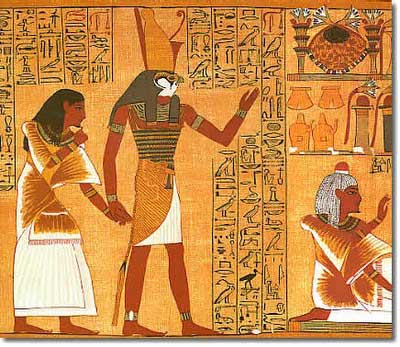
The earliest known primitive shrines appeared in Egypt by the late Predynastic Period, in the late fourth millennium BC. These shrines were made of perishable materials such as wood, reed matting, and mudbrick. Despite the impermanence of these early buildings, later Egyptian art continually reused and adapted elements from them, evoking the ancient shrines to suggest the eternal nature of the gods and their dwelling places.
In the Early Dynastic Period (c. 3100-2686 BC), the first pharaohs built funerary complexes in the religious center of Abydos following a single general pattern, with a rectangular mud-brick enclosure that may have contained an off-center earthen mound. It is unclear whether, in this early time, temples in other areas of the country received royal patronage or were influenced by the royal temple style. In any case, in the Old Kingdom (c. 2686-2181 BC) that followed the Early Dynastic Period, royal funerary monuments underwent tremendous expansion, while most divine temples remained comparatively small, suggesting that official religion in this period emphasized the cult of the divine king more than the direct worship of deities.
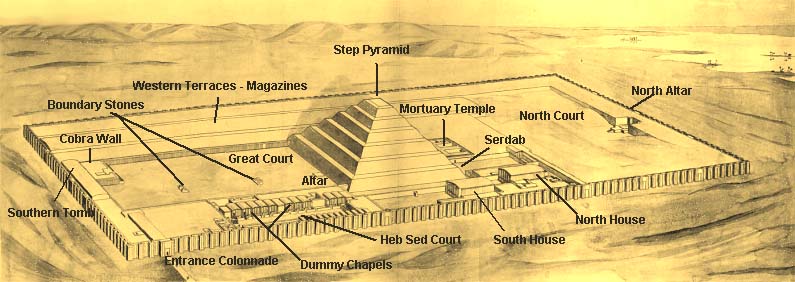
The expansion of funerary monuments began in the reign of Djoser, who built his complex entirely of stone and replaced the interior mound with a step pyramid under which he was buried (the Pyramid of Djoser). For the rest of the Old Kingdom, tomb and temple were joined in elaborate stone pyramid complexes. Near each pyramid complex was a town that supplied its needs as towns would support temples throughout Egyptian history.
Other changes came in the reign of Sneferu, who, beginning with his first pyramid at Meidum, built pyramid complexes symmetrically along an east-west axis, with a valley temple on the banks of the Nile linked to a pyramid temple at the foot of the pyramid. Sneferu's immediate successors followed this pattern, but beginning in the late Old Kingdom, pyramid complexes combined different elements from the axial plan and from the rectangular plan of Djoser.
To supply the massive pyramid complexes, kings founded new towns and farming estates on undeveloped lands across Egypt. The flow of goods from these lands to the central government and its temples helped unify the kingdom. Yet as temples and their priesthoods grew more economically influential, they became nearly independent of royal control, weakening the central government and contributing to the collapse of the Old Kingdom.
The rulers of the Middle Kingdom (c. 2055-1650 BC), who reunified the country after this collapse, continued building pyramids and their associated complexes. The rare remains from Middle Kingdom temples, like the one at Medinet Madi, show that temple plans grew more symmetrical during that period, and divine temples made increasing use of stone. The pattern of a sanctuary lying behind a pillared hall frequently appears in Middle Kingdom temples, and sometimes these two elements are fronted by open courts, foreshadowing the standard temple layout used in later times.
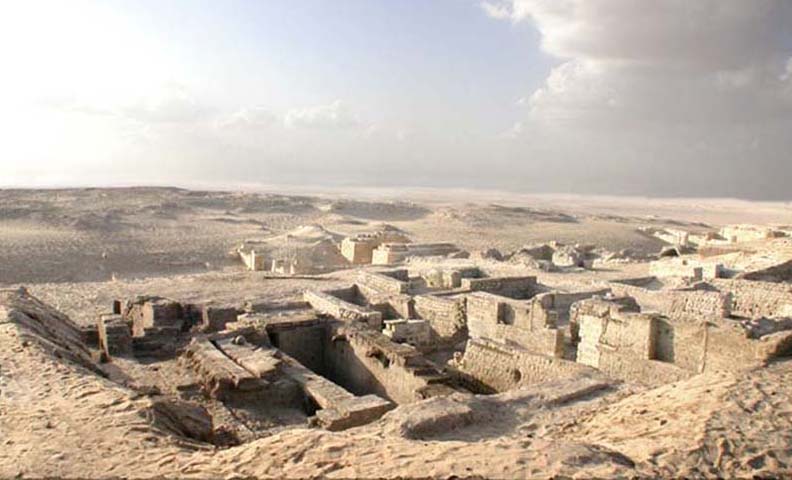
Medinet Madi means "City of the Past"
With greater power and wealth during the New Kingdom (c. 1550-1070 BC), Egypt devoted still more resources to its temples, which grew larger and more elaborate. Higher-ranking priestly roles became permanent rather than rotating positions, and once again they controlled a large portion of Egypt's wealth. It is possible that, as the influence of temples expanded, religious celebrations that had once been fully public were absorbed into the temples' increasingly important festival rituals. The most important god of the time was Amun, whose main cult center, the Precinct of Amun-Re at Karnak in Thebes, eventually became the largest of all temples, and whose priesthood wielded considerable political influence.
Many temples were now built entirely of stone, and their general plan became fixed, with the sanctuary, halls, courtyards, and pylon gateways oriented along the path used for festival processions. New Kingdom pharaohs ceased using pyramids as funerary monuments and placed their tombs a great distance from their mortuary temples. Without pyramids to build around, mortuary temples began using the same plan as those dedicated to the gods.
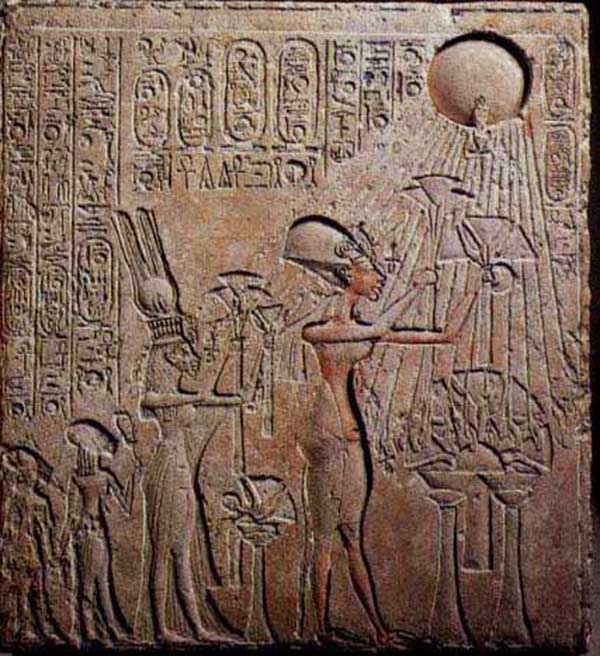
In the middle of the New Kingdom, Pharaoh Akhenaten promoted the god Aten over all others and eventually abolished the official worship of most other gods. Traditional temples were neglected while new Aten temples, differing sharply in design and construction, were erected. But Akhenaten's revolution was reversed soon after his death, with the traditional cults reinstated and the new temples dismantled. Subsequent pharaohs dedicated still more resources to the temples, particularly Ramesses II, the most prolific monument-builder in Egyptian history.
As the wealth of the priesthoods continued to grow, so did their religious influence: temple oracles, controlled by the priests, were an increasingly popular method of making decisions. Pharaonic power waned, and in the 11th century BC the High Priests of Amun were able to take control of all Upper Egypt, beginning the political fragmentation of the Third Intermediate Period (c. 1070-664 BC).
As the New Kingdom crumbled, the building of mortuary temples ceased and was never revived. However, some rulers of the Third Intermediate Period were buried within the enclosures of divine temples, thus continuing the close link between temple and tomb.
In the Late Period (664-323 BC), the weakened Egyptian state fell to a series of outside powers, experiencing only occasional periods of independence. Many of these foreign rulers funded and expanded temples to strengthen their claim to the kingship of Egypt. The Kushite pharaohs of the 8th and 7th centuries BC, restored the temple at Karnak and adopted Egyptian style temple architecture for use in their native land of Nubia. This began a long tradition of sophisticated Nubian temple building. Amid this turmoil the fortunes of various temples and clergies shifted, and the independence of Amun's priesthood was broken, but the power of the priesthood in general remained.
Despite the political upheaval, the Egyptian temple continued to evolve without absorbing much foreign influence. Whereas earlier temple building mostly focused on male gods, goddesses and child deities grew increasingly prominent. Temples focused more on popular religious activities such as oracles, animal cults, and prayer. New architectural forms continued to develop, such as covered kiosks in front of gateways, more elaborate column styles, and the mammisi, a building celebrating the mythical birth of a god. Though the characteristics of the late temple style had developed by the last period of native rule, most of the examples date from the era of the Ptolemies, Greek kings who ruled as pharaohs for nearly 300 years.
After Rome conquered the Ptolemaic kingdom in 30 BC, Roman emperors took on the role of ruler and temple patron. The funds bestowed by Augustus and the 1st century emperors appear to have markedly declined due to the economic travails of the wider empire in the 3rd century AD with major temples in a state of progressive ruin.
Temple-building continued down until the 4th century AD. However, with the rise of the Christian Roman Emperors temples lost their traditional state funding, had their treasures melted down, and the proceeds redirected towards the building of churches.
In AD 391 all pagan cults were banned by Theodosius I and in this same year the Serapeum of Alexandria was destroyed by Christians. Attacks on pagans and temples were widespread throughout Egypt.
In AD 550, Philae, the last major functioning temple in Egypt, was closed.
Temples were built throughout Upper and Lower Egypt, as well as at Egyptian-controlled oases in the Libyan Desert as far west as Siwa, and at outposts in the Sinai Peninsula such as Timna. In periods when Egypt dominated Nubia, Egyptian rulers also built temples there, as far south as Jebel Barkal. Most Egyptian towns had a temple, but in some cases, as with mortuary temples or the temples in Nubia, the temple was a new foundation on previously empty land.
The exact site of a temple was often chosen for religious reasons; it might, for example, be the mythical birthplace or burial place of a god. The temple axis might also be designed to align with locations of religious significance, such as the site of a neighboring temple or the rising place of the sun or particular stars. The Great Temple of Abu Simbel, for instance, is aligned so that twice a year the rising sun illuminates the statues of the gods in its innermost room. Most temples, however, were aligned toward the Nile with an axis running roughly east-west.
An elaborate series of foundation rituals preceded construction. A further set of rituals followed the temple's completion, dedicating it to its patron god. These were conducted, at least in theory, by the king as part of his religious duties; indeed, in Egyptian belief all temple construction was symbolically his work. In reality, it was the work of hundreds of his subjects, conscripted in the state corvee system. Using mostly stone and wood tools, they built the massive temple structures in construction processes that lasted years or even decades.
The use of stone in Egyptian temples emphasized their purpose as eternal houses for the gods and set them apart from buildings for the use of mortals, which were built of mudbrick. However, early temples were built of brick and other perishable materials, and most of the outlying buildings in temple enclosures remained brick-built throughout Egyptian history. The main stones used in temple construction were limestone and sandstone, which are common in Egypt; stones that are harder and more difficult to carve, such as granite, were used in smaller amounts for individual elements like obelisks. The stone to build a temple might be quarried nearby or shipped on the Nile from quarries elsewhere.
Temple structures were built on foundations of stone slabs set into sand-filled trenches. Walls and other structures were built with large blocks of varying shapes. The blocks were laid in courses, usually without mortar. Each stone was dressed to fit with its neighbors, producing cuboid blocks whose uneven shapes interlocked. The interiors of walls were often built with less care, using rougher, poorer-quality stones. To build structures above ground level, the workers used massive construction ramps. When cutting chambers in living rock, workers excavated from the top down, carving a crawlspace near the ceiling and cutting down to the floor.
Once the temple structure was complete, the rough faces of the stones were dressed to create a smooth surface. In decorating these surfaces, reliefs were carved into the stone or, if the stone was too poor-quality to carve, a layer of plaster that covered the stone surface. Reliefs were then decorated with gilding, inlay, or paint. The paints were usually mixtures of mineral pigments with some kind of adhesive, possibly natural gum.
Temple construction did not end once the original plan was complete; pharaohs often rebuilt or replaced decayed temple structures or made additions to those still standing. In the course of these additions, they frequently dismantled old temple buildings to use as fill for the interiors of new structures. On rare occasions this may have been because the old structures or their builders had become anathema, as with Akhenaten's temples, but in most cases the reason seems to have been convenience. Such expansion and dismantling could considerably distort the original temple plan, as happened at the enormous Precinct of Amun-Re at Karnak, which developed two intersecting axes and several satellite temples.
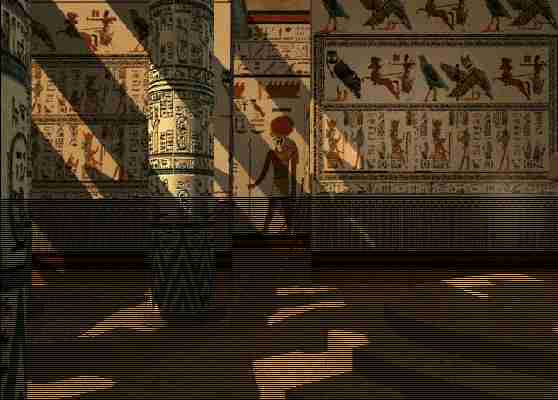
Like all ancient Egyptian architecture, Egyptian temple designs emphasized order, symmetry, and monumentality and combined geometric shapes with stylized organic motifs. Elements of temple design also alluded to the form of the earliest Egyptian buildings. Cavetto cornices at the tops of walls, for instance, were made to imitate rows of palm fronds placed atop archaic walls, and the batter of exterior walls, while partly meant to ensure balance, was also a holdover from archaic building methods.
Temple ground plans usually centered on an axis running on a slight incline from the sanctuary down to the temple entrance. In the fully developed pattern used in the New Kingdom and later, the path used for festival processions - a broad avenue punctuated with massive doors - served as this central axis. The path was intended primarily for the god's use when it traveled outside the sanctuary; on most occasions people used smaller side doors. The typical parts of a temple, such as column-filled hypostyle halls, open peristyle courts, and towering entrance pylons, were arranged along this path in a traditional but flexible order. Beyond the temple building proper, the outer walls enclosed numerous satellite buildings.
The temple pattern could vary considerably, apart from the distorting effect of additional construction. Many temples (rock temples) were cut entirely into living rock, as at Abu Simbel, or had rock-cut inner chambers with masonry courtyards and pylons, as at Wadi es-Sebua. They used much the same layout as free-standing temples but used excavated chambers rather than buildings for their inner rooms. In some temples, like the mortuary temples at Deir el-Bahari, the processional path ran up a series of terraces rather than sitting on a single level. The most idiosyncratic temple style was that of the Aten temples built by Akhenaten at el-Amarna, in which the axis passed through a series of entirely open courts filled with altars.
The traditional pattern was highly symbolic. It was a greatly elaborated variant on the design of an Egyptian house, reflecting its role as the god's home. Moreover, the temple represented a piece of the divine realm on earth. The elevated, enclosed sanctuary was equated with the sacred hill where the world was created in Egyptian myth and with the burial chamber of a tomb, where the god's ba, or spirit, came to inhabit its cult image just as a human ba came to inhabit its mummy.
This crucial place, the Egyptians believed, had to be insulated from the impure outside world. Therefore, as one moved toward the sanctuary the amount of outside light decreased, and restrictions on who could enter increased. Yet the temple could also represent the world itself. The processional way could therefore stand for the path of the sun traveling across the sky, and the sanctuary for the Duat where it was believed to set and to be reborn at night. The space outside the building was thus equated with the waters of chaos that lay outside the world, while the temple represented the order of the cosmos and the place where that order was continually renewed.
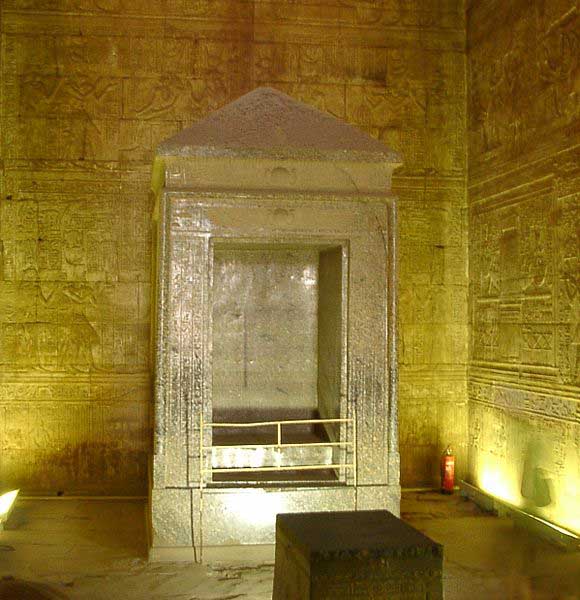
Shrine in the sanctuary of Edfu Temple
The temple's inner chambers centered on the sanctuary of the temple's primary god, which typically lay along the axis near the back of the temple building, and in pyramid temples directly against the pyramid base. The sanctuary was the focus of temple ritual, the place where the divine presence manifested most strongly. The form in which it manifested itself varied. In Aten temples and traditional solar shrines, the object of ritual was the sun itself, worshipped in a court open to the sky. In many mortuary temples, the inner areas contained statues of the deceased pharaoh, or a false door where his ba was believed to appear to receive offerings.
In most temples, however, the focus was the cult image: a statue of the temple god which that god's ba was believed to inhabit while interacting with humans. The sanctuary in these temples contained either a naos, a cabinet-like shrine that housed the divine image, or a model barque containing the image within its cabin, which was used to carry the image during festival processions. To emphasize the sanctuary's sacred nature, it was kept in total darkness. Whereas in earlier times the sanctuary lay at the very back of the building, in the Late and Ptolemaic periods it became a freestanding building inside the temple, further insulated from the outside world by the surrounding corridors and rooms.
Subsidiary chapels, dedicated to deities associated with the primary god, lay to the sides of the main one. When the main temple god was male, the secondary chapels were often dedicated to that god's mythological consort and child. The secondary chapels in mortuary temples were devoted to gods associated with kingship.
Several other rooms neighbored the sanctuary. Many of these rooms were used to store ceremonial equipment, ritual texts, or temple valuables; others had specific ritual functions. The room where offerings were given to the deity was often separate from the sanctuary itself, and in temples without a barque in the sanctuary, there was a separate shrine to store the barque.
In late temples the ritual areas could extend to chapels on the roof and crypts below the floor. Finally, in the exterior wall at the back of the temple, there were often niches for laymen to pray to the temple god, as close as they could come to its dwelling place.
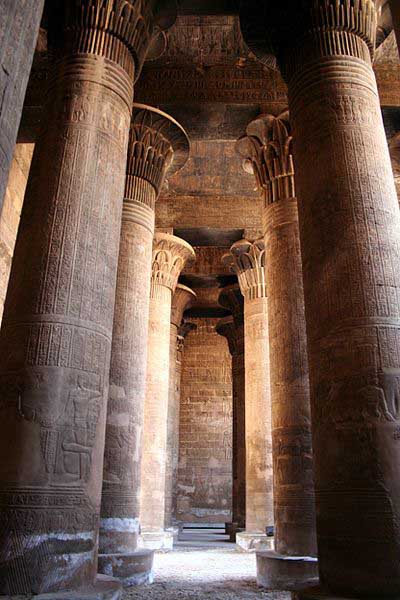
Hypostyle Hall of Esna Temple
Hypostyle halls, covered rooms filled with columns, appear in temples throughout Egyptian history. By the New Kingdom they typically lay directly in front of the sanctuary area. These halls were less restricted than the inner rooms, being open to laymen at least in some cases.They were often less dark as well: New Kingdom halls rose into tall central passages over the processional path, allowing a clerestory to provide dim light. The epitome of this style is the Great Hypostyle Hall at Karnak, whose largest columns are 69 feet (21 m) tall.
In later periods, the Egyptians favored a different style of hall, where a low screen wall at the front let in the light. The shadowy halls, whose columns were often shaped to imitate plants such as lotus or papyrus, were symbolic of the mythological marsh that surrounded the primeval mound at the time of creation. The columns could also be equated with the pillars that held up the sky in Egyptian cosmology.
Beyond the hypostyle hall were one or more peristyle courts open to the sky. These open courts, which had been a part of Egyptian temple design since the Old Kingdom, became transitional areas in the standard plan of the New Kingdom, lying between the public space outside the temple and the more restricted areas within. Here the public met with the priests and assembled during festivals.
At the front of each court was usually a pylon, a pair of broad, flat towers flanking the main gateway. The pylon is known from only scattered examples in the Old and Middle Kingdoms, but in the New it quickly became the distinctive and imposing faŤade common to most Egyptian temples. The pylon served symbolically as a guard tower against the forces of disorder, and may also have been meant to resemble the hieroglyph for "horizon", underscoring the temple's solar symbolism.
The front of every pylon held niches for pairs of flagpoles to stand. Unlike pylons, such flags had stood at temple entrances since the earliest Predynastic shrines. They were so closely associated with the presence of a deity that the hieroglyph for them came to stand for the Egyptian word for "god".
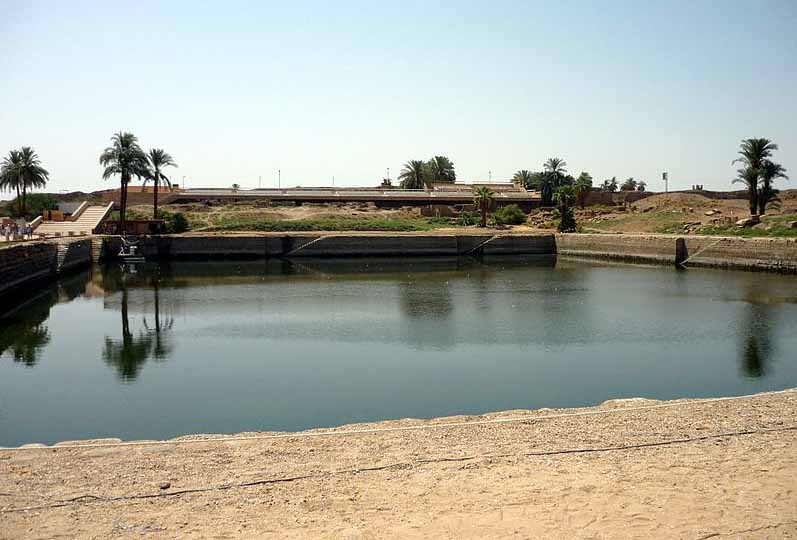
Sacred Lake at Karnak
Outside the temple building proper was the temple enclosure, surrounded by a rectangular brick wall that symbolically protected the sacred space from outside disorder. On occasion this function was more than symbolic, especially during the last native dynasties in the fourth century BC, when the walls were fully fortified in case of Persian invasion. In late temples these walls frequently had alternating concave and convex courses of bricks, so that the top of the wall undulated vertically. This pattern may have been meant to evoke the mythological waters of chaos.
The walls enclosed many buildings related to the temple's function. Some enclosures contained satellite chapels dedicated to deities associated with the temple god, including mammisis celebrating the birth of the god's mythological child. The sacred lakes found in many temple enclosures served as reservoirs for the water used in rituals, as places for the priests to ritually cleanse themselves, and as representations of the water from which the world emerged.
Mortuary temples sometimes contained a palace for the spirit of the king to whom the temple was dedicated, built against the temple building proper. Sanatoria in some temples provided a place for the sick to await healing dreams sent by the god. Other temple buildings included kitchens, workshops, and storehouses to supply the temple's needs.
Especially important was the "House of Life". The house of life also functioned as a general center of learning, containing works on non-religious subjects such as history, geography, astronomy, and medicine. Although these outlying buildings were devoted to more mundane purposes than the temple itself, they still had religious significance; even granaries might be used for specific ceremonies.
Through the enclosure ran the processional path, which led from the temple entrance through the main gate in the enclosure wall. The path was frequently decorated with sphinx statues and punctuated by barque stations, where the priests carrying the festival barque could set it down to rest during the procession. The processional path usually ended in a quay on the Nile, which served as the entrance point for river-borne visitors and the exit point for the festival procession when it travelled by water. In Old Kingdom pyramid temples, the quay adjoined an entire temple (the valley temple), which was linked to the pyramid temple by the processional causeway.
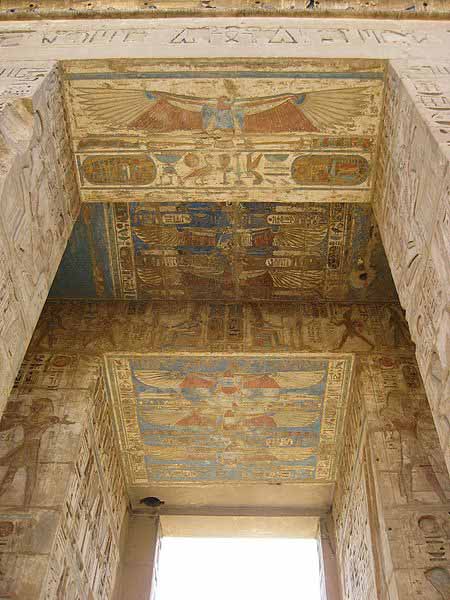
Decoration on doorframes and ceilings at Medinet Habu
The temple building was elaborately decorated with reliefs and free-standing sculpture, all with religious significance. As with the cult statue, the gods were believed to be present in these images, suffusing the temple with sacred power. Symbols of places in Egypt or parts of the cosmos enhanced the mythical geography already present in the temple's architecture. Images of rituals served to reinforce the rituals' magical effect and to perpetuate that effect even if the rituals ceased to be performed. Because of their religious nature, these decorations showed an idealized version of reality, emblematic of the temple's purpose rather than real events. For instance, the king was shown performing all rituals, while priests, if depicted at all, were secondary. It was unimportant that he was almost never present for these ceremonies; it was his broader role as intermediary with the gods that mattered.
The most important form of decoration is relief. Relief became more extensive over time, and in late temples, walls, ceilings, columns, and beams were all decorated, as were free-standing stelae erected within the enclosure. Egyptian artists used both bas relief and sunken relief. Bas relief allowed more subtle artistry but involved more carving than sunken relief. Sunken relief was therefore used on harder, more difficult stone and when the builders wanted to finish quickly, although it was also appropriate for exterior surfaces, where the shadows it created made the figures stand out in bright sunlight. Finished reliefs were painted using the basic colors black, white, red, yellow, green, and blue, although the artists often mixed pigments to create other colors. In some cases, gilding or inlaid pieces of colored glass or faience substituted for paint.
The reliefs, including both images and hieroglyphic text, are among the most important sources of information on Ancient Egypt. They contain calendars of festivals, accounts of myths, depictions of rituals, and the texts of hymns. Pharaohs recorded their temple-building activities and their campaigns against the enemies of Egypt.The Ptolemaic temples go further to include information of all kinds taken from temple libraries. The decoration in a given room either depicts the actions performed there or has some symbolic tie to the room's purpose, providing abundant information on temple activities.
Free-standing temple sculpture included obelisks, tall, pointed pillars, associated with the sun in Egyptian iconography. The largest of them, the Lateran Obelisk, was more than 118 feet (36 m) high. They were often placed in pairs in front of pylons or elsewhere along the temple axis. Statues of the king, which were similarly placed, also reached colossal size; the Colossi of Memnon at the mortuary temple of Amenhotep III and the statue of Ramesses II at the Ramesseum are the largest free-standing statues made in ancient Egypt. There were also figures of gods, often in sphinx form, that served as symbolic guardians of the temple. The most numerous statues were votive figures donated to the temple by kings, private individuals, or even towns to gain divine favor. These could depict the god to whom they were dedicated or the people who donated the statue, or both. The most essential temple statues were the cult images, which were usually made of or decorated with precious materials such as gold and lapis lazuli.
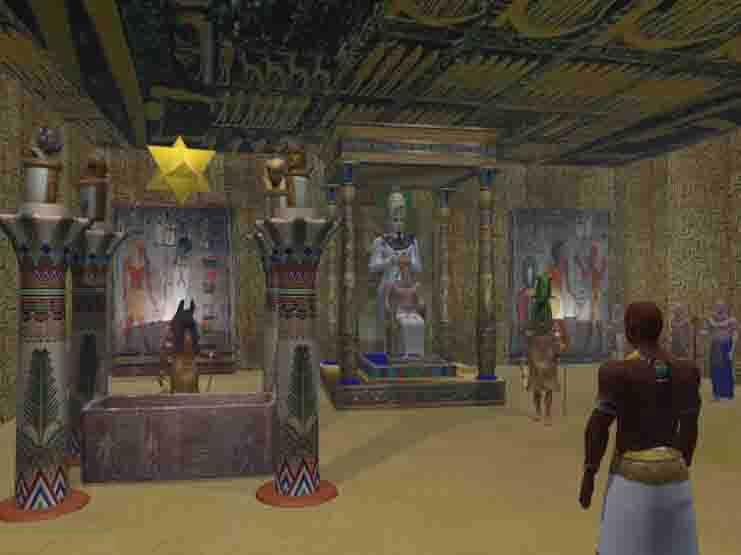

A temple needed many people to perform its rituals and support duties. Priests performed the temple's essential ritual functions, but in Egyptian religious ideology they were far less important than the king. As temple decoration illustrates, all ceremonies were, in theory, acts by the king, and priests merely stood in his place. The priests were therefore subject to the king's authority, and he had the right to appoint anyone he wished to the priesthood. In fact, in the Old and Middle Kingdoms most priests were government officials who left their secular duties for part of the year to serve the temple in shifts.
Once the priesthood became more professional, the king seems to have used his power over appointments mainly for the highest-ranking positions, usually to reward a favorite official with a job or to intervene for political reasons in the affairs of an important cult. Lesser appointments he delegated to his vizier or to the priests themselves. In such cases, the holder of an office named his own son as his successor, or the temple clergy conferred to decide who should fill an empty post. Priestly offices were extremely lucrative and tended to be held by the wealthiest and most influential members of Egyptian society.
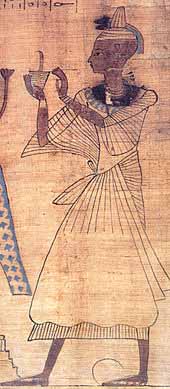
The requirements for the priesthood varied over time and among the cults of different gods. Although detailed theological knowledge was involved in priestly offices, little is known about what knowledge or training may have been required of the officeholders. Priests were, however, required to observe strict standards of ritual purity in the sacred space.
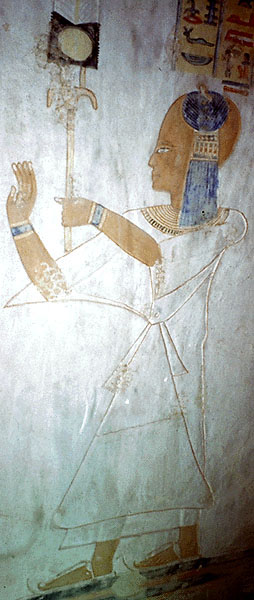
They shaved their heads and bodies, washed several times a day, and wore only clean linen clothing. They were not required to be celibate, but sexual intercourse rendered them unclean until they underwent further purification. The cults of specific gods might impose additional restrictions related to that god's mythology, such as rules against eating the meat of a species associated with the god. The acceptance of women into the priesthood was variable.
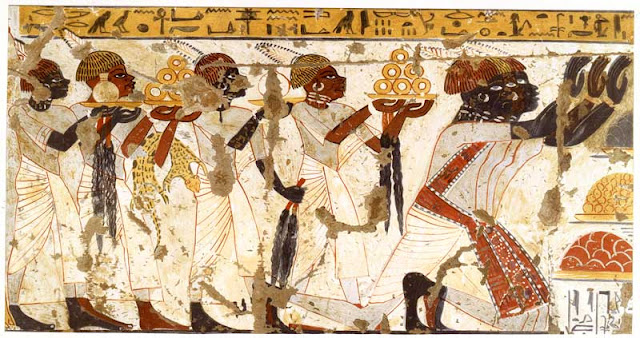
In the Old Kingdom many women served as priests, but their presence in clergies declined drastically in the Middle Kingdom before increasing in the Third Intermediate Period. Lesser positions, such as that of musician in ceremonies, remained open to women in even the most restrictive periods, as did the special role of ceremonial consort of the god. This latter role was highly influential, and the most important of these consorts, the God's Wife of Amun, even supplanted the High Priest of Amun during the Late Period.
At the head of the temple hierarchy was the high priest, who oversaw all the temple's religious and economic functions and in the largest cults was an important political figure. Beneath him might be as many as three subordinate priests who could substitute for him in ceremonies. While these higher ranks were full-time positions from the New Kingdom onward, the lower grades of priesthood still worked in shifts over the course of the year.While many priests did a variety of menial tasks, the clergy also contained several ritual specialists.
Prominent among these specialized roles was that of the lector priest who recited hymns and spells during temple rituals, and who hired out his magical services to laymen. Besides its priests, a large temple employed singers, musicians, and dancers to perform during rituals, plus the farmers, bakers, artisans, builders, and administrators who supplied and managed its practical needs. A major cult, therefore, could have well over 150 full or part-time priests, with tens of thousands of non-priestly employees working on its lands across the country. These numbers contrast with mid-sized temples, which may have had 10 to 25 priests, and with the smallest provincial temples, which might have only one.
At certain times there was an administrative office that presided over all temples and clergies. In the Old Kingdom, pharaohs gave this authority first to their relatives and then to their viziers. In the reign of Thutmose III the office passed from the viziers to the High Priests of Amun, who held it for much of the New Kingdom. The Romans established a similar office, that of Idios Logos, which oversaw the Egyptian cults until their extinction.
The daily offering ritual was much the same across Egypt, though the exact sequence of events is uncertain. At sunrise, the officiating priest entered the sanctuary, carrying a candle to light the room. He opened the doors of the shrine and prostrated himself before the god's image, reciting hymns in its praise. After purifying the room with water and incense, the priest presented a figurine of the goddess Maat to the god, an act that represented the purpose of the entire ceremony. Then he removed the god from the shrine, clothed it (replacing the clothes of the previous day), and anointed it with oil and paint.
At some point the priest also offered a meal, including a variety of meats, fruits, vegetables, and bread. The god was believed to consume only the spiritual essence of this meal. This belief allowed the food to be distributed to others, an act that the Egyptians called the "reversion of offerings". The food passed first to the other statues throughout the temple, then to local funerary chapels for the sustenance of the dead, and finally to the priests who actually ate it.
Other offering rituals took place at noon and at sunset, though the sanctuary was not reopened. Some ceremonies other than offerings also took place daily, including rituals specific to a particular god. In the cult of the sun god Ra, for instance, hymns were sung day and night for every hour of the god's journey across the sky. Many of the ceremonies acted out in ritual the battle against of the forces of chaos. They might, for instance, involve the destruction of models of inimical gods like Apep or Set, acts which were believed to have a real effect through the principles of Egyptian magic.
In fact, the Egyptians believed that all ritual actions achieved their effect through magic. To the Egyptians, magic, or heka, was a fundamental force that rituals were meant to manipulate. Using magic, people, objects, and actions were equated with counterparts in the divine realm and thus were believed to affect events among the gods. In the daily offering, for instance, the cult statue, regardless of which deity it represented, was associated with Osiris, god of the dead.
The priest performing the ritual was identified with Horus, the living son of Osiris, who in mythology sustained his father after death through offerings. This relationship was the template for the relationship between living people and the dead to whom they gave offerings, and it eventually became the template for all relationships between those in the living world and those in the divine realm. By magically equating himself with a god in a myth, the priest was able to interact with the temple deity.
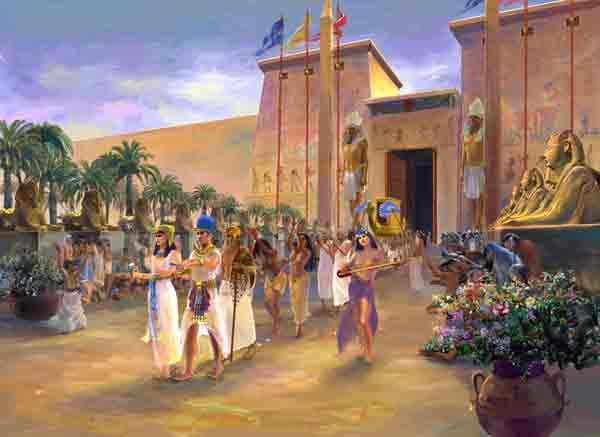
On days of particular religious significance, the daily rituals were replaced with festival observances. Different festivals occurred at different intervals, though most were annual. Their timing was based on the Egyptian civil calendar, which most of the time was far out of step with the actual year. Thus, while many festivals had a seasonal origin, their timing lost its connection with actual seasons.
Most festivals took place at a single temple, but others could involve two or more temples or an entire region of Egypt; a few were celebrated throughout the country. In the New Kingdom and later, the festival calendar at a single temple could include dozens of events, so it is likely that most of these events were observed only by the priests. However, in those festivals that involved a procession outside the temple, the local population also gathered to watch and to celebrate. These were the most elaborate temple ceremonies, accompanied by the recitation of hymns and the performance of musicians.
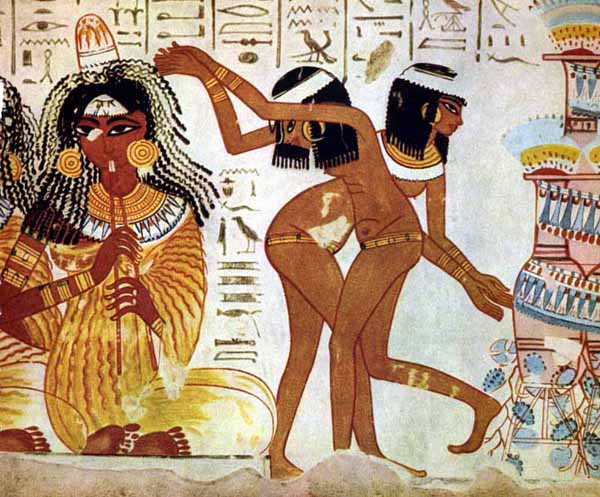
Festival ceremonies entailed reenactment of mythological events or the performance of other symbolic acts, like the cutting of a sheaf of wheat during the harvest-related festival dedicated to the god Min. Many such ceremonies took place only within the temple building, but often a festival entailed a visit by the temple god to the temple of another god. This was the occasion of the festival procession, when priests carried the divine image out from the sanctuary in its model barque.
The barque might travel entirely on land or be loaded onto a real boat to travel on the river. The purpose of the god's visit varied. Some were related to sex and fertility: in the Ptolemaic period, an image of Hathor from Dendera Temple was brought annually to Edfu, the temple of her mythological consort Horus, and the images of the two gods spent several nights together in the mammisi that celebrated the birth of their child Harsomptus.
Other festival journeys were tied to the ideology of kingship. One of these was the Opet Festival, an extremely important ceremony during the New Kingdom, in which the image of Amun from Karnak visited the form of Amun worshipped at Luxor Temple, and both acted to reaffirm the king's divine rule. Still other celebrations had a funerary character, as in the Beautiful Feast of the Valley, when Amun of Karnak went to Medinet Habu to perform funerary rites for the eight gods of the Ogdoad, who were said to be buried there. The varied ceremonies were united by the broad purpose of renewing life among the gods and in the cosmos.
The gods involved in a festival also received various offerings in much larger quantities than in daily ceremonies. The enormous amounts of food listed in festival texts are unlikely to have been divided among the priests alone, so it is likely that the celebrating commoners also participated in the reversion of these offerings.
Some temples kept sacred animals, which were believed to be manifestations of the temple god's ba in the same way that cult images were. Each of these sacred animals was kept in the temple and worshipped for a certain length of time, ranging from a year to the lifetime of the animal. At the end of that time, it was replaced with a new animal of the same species, which was selected by a divine oracle or based on specific markings that were supposed to indicate its sacred nature. Among the most prominent of these animals were the Apis bull, worshipped at Memphis as a manifestation of the Memphite god Ptah, and the falcon at Edfu who represented the falcon god Horus.
During the Late Period, a different form of worship involving animals developed. In this case, laymen paid the priests to kill, mummify, and bury an animal of a particular species as an offering to a god. These animals were not regarded as especially sacred, but as a species they were associated with the god because it was depicted in the form of that animal. The god Thoth, for instance, could be depicted as an ibis and as a baboon, and both ibises and baboons were given to him. Although this practice was distinct from the worship of single divine representatives, some temples kept stocks of animals that could be selected for either purpose.
By the beginning of the New Kingdom, and quite possibly earlier, the festival procession had become an opportunity for people to seek oracles from the god. Their questions dealt with subjects ranging from the location of a lost object to the best choice for a government appointment. The motions of the barque as it was carried on the bearers' shoulders - making simple gestures to indicate "yes" or "no", tipping toward tablets on which possible answers were written, or moving toward a particular person in the crowd - were taken to indicate the god's reply.
By the Third Intermediate Period, oracles expanded beyond the festival, allowing people to consult them frequently. Priests interpreted the movements of sacred animals or, being asked questions directly, wrote out or spoke answers that they had supposedly received from the god in question. The priests' supposed ability to speak for the gods or interpret their messages gave them great political influence and provided the means for the High Priests of Amun to dominate Upper Egypt during the Third Intermediate Period.
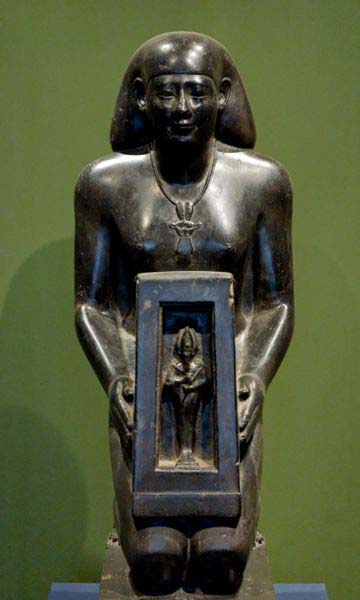
Votive statue of a man donating a
shrine containing a figure of Osiris
A votive deposit or votive offering is one or more objects displayed or deposited, without the intention of recovery or use, in a sacred place for broadly religious purposes. Such items are a feature of modern and ancient societies and are generally made in order to gain favor with supernatural forces. Some offerings have apparently been made in anticipation of the achievement of a particular wish, but in Western cultures from which documentary evidence survives it has been more typical to wait until the wish has been fulfilled before making the offering.
Although they were excluded from the formal rituals of the temple, laymen still sought to interact with the gods. There is little evidence of the religious practices of individual people from early Egyptian history, so Egyptologists' understanding of the subject derives mostly from the New Kingdom or later periods. The evidence from those times indicates that while ordinary Egyptians used many venues to interact with the divine, such as household shrines or community chapels, the official temples with their sequestered gods were a major focus for popular veneration.
Unable to address the cult image directly, laymen still attempted to convey their prayers to it. At times they related messages to priests to deliver to the temple deity; at other times they expressed their piety in the parts of the temple that they could access. Courts, doorways, and hypostyle halls might have spaces designated for public prayer. Sometimes people directed their appeals to the royal colossi, which were believed to act as divine intermediaries. More private areas for devotion were located at the building's outer wall, where large niches served as "chapels of the hearing ear" for individuals to speak to the god.
The Egyptians also interacted with deities through the donation of offerings, ranging from simple bits of jewelry to large and finely carved statues and stelae. Among their contributions were statues that sat in temple courts, serving as memorials to the donors after their deaths and receiving portions of the temple offerings to sustain the donors' spirits. Other statues served as gifts to the temple god, and inscribed stelae conveyed to the resident deity the donors' prayers and messages of thanks. Over the centuries, so many of these statues accumulated within a temple building that priests sometimes moved them out of the way by burying them in caches beneath the floor. Commoners offered simple clay models. The form of these models often indicated the reason for their donation; figures depicting a woman with a child on a bed, for instance, indicate a prayer for a safe childbirth.
Festival processions offered a chance for laymen to approach and perhaps even glimpse the cult image in its barque, and for them to receive portions of the god's food. However, because the key rituals of any festival still took place within the temple, out of public sight, Egyptologist Anthony Spalinger has questioned whether the processions inspired genuine "religious feelings" or were simply seen as occasions for revelry.
In any case, the oracular events during festivals provided an opportunity for people to receive responses from the normally isolated deities, as did the other varieties of oracle that developed late in Egyptian history. Temples eventually became a venue for yet another type of divine contact: dreams. The Egyptians saw dreaming as a means of communion with the divine realm, and by the Ptolemaic period many temples provided buildings where people slept in hopes of contacting the temple god. These petitioners often sought a magical solution to sickness or infertility, but at other times they simply sought an answer to a question, receiving the answer through a dream rather than an oracle.
After their original religious activities ceased, Egyptian temples suffered slow decay. Many were defaced or dismantled by Christians trying to erase the remnants of paganism. A few, such as Luxor and Philae , were converted into churches, but many more went completely disused, and over time locals carried off their stones to use as material for new buildings.
What humans left intact was still subject to natural weathering. Temples in desert areas could be covered by drifts of sand, while those near the Nile, particularly in Lower Egypt, were often completely buried under layers of river-borne silt. Thus, some major temple sites like Memphis and Heliopolis were reduced to ruin, while many temples far from the Nile and centers of population remained mostly intact. With understanding of the hieroglyphic script lost, the information about Egyptian culture and beliefs that was preserved in the surviving temples lay incomprehensible to the world.
The situation changed dramatically with the French military expedition to Egypt in 1798, which brought with it a corps of scholars to examine the surviving ancient monuments. The results of their study inspired a fascination with ancient Egypt throughout Europe. In the early nineteenth century, growing numbers of Europeans began traveling to Egypt, both to see the ancient monuments and to collect Egyptian antiquities.
Many temple artifacts, from small objects to massive obelisks, were removed by outside governments and private collectors. This wave of Egyptomania resulted in the rediscovery of temple sites such as Abu Simbel, but artifacts and even whole temples were often treated with great carelessness. The discoveries of the period did, however, make possible the decipherment of Egyptian hieroglyphs and the beginnings of Egyptology as a science.
Nineteenth-century Egyptologists studied the temples intensively, but their emphasis was on collection of artifacts to send to their own countries, and their slipshod excavation methods often did further harm. Slowly, however, the antique-hunting attitude toward Egyptian monuments gave way to careful study and preservation efforts. The government also took greater control of archaeological activity as Egypt's independence from foreign powers increased. Yet even in recent times the ancient remains have faced threats.
The most severe was the construction of the Aswan High Dam in the 1960s, which threatened to submerge the temples in what had been Lower Nubia, including Philae and Abu Simbel, under the newly formed Lake Nasser. A massive effort by the United Nations disassembled some of the threatened monuments and rebuilt them on higher ground, and the Egyptian government gave several of the others as gifts to nations that had contributed to the preservation effort. Nevertheless, several other temples vanished beneath the lake.
Today there are dozens of sites with substantial temple remains, although many more once existed, and none of the major temples in Lower or Middle Egypt are well preserved. Those that are well preserved, such as Karnak, Luxor, and Abu Simbel, draw tourists from around the world and are therefore a key attraction for the Egyptian tourist industry, which is a major sector of the Egyptian economy.
ANCIENT AND LOST CIVILIZATIONS